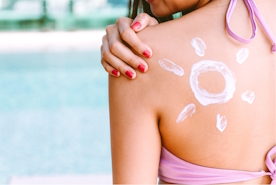
Call 0330 880 3600 Calls may be monitored or recorded. Opening Times.
- TRAVEL INSURANCE
- COVID-19 ENHANCED COVER
- More Options
- Help & Advice
- Existing Customers

Call 0330 880 3600 Calls may be monitored or recorded. Opening Times.

We all have melanin in our skin, it’s a pigment which not only plays a role in determining the colour of your skin, but also in the protection you have against UVA and UVB rays. Melanin absorbs these rays and acts as a first line of defence, but when there’s too much UV for our melanin to handle, we get sunburnt. A sunburn tells us we’re damaging our skin, while a tan is a result of the injury.
 You’ll be fine though, slap a bit of aftersun on and your skin can start repairing - right? Well, not really. Aftersun can soothe the soreness of a burn but it won’t fix the damage done to your DNA by UV rays. Imagine your sunburn as a wound which will never fully heal, and get out of the sun when your skin starts burning.
You’ll be fine though, slap a bit of aftersun on and your skin can start repairing - right? Well, not really. Aftersun can soothe the soreness of a burn but it won’t fix the damage done to your DNA by UV rays. Imagine your sunburn as a wound which will never fully heal, and get out of the sun when your skin starts burning.
So, there are two important things to look out for when you’re buying sun cream:
It’s worth knowing that more expensive sun creams do not necessarily offer better protection. They’re well-regulated, so as long as it has an SPF and star rating, you can trust the product whether it’s £3 or £23. Make sure you pick one you don’t hate so you’re more likely to use it, especially since you should be applying it generously to your whole body.
You might think you only need sun cream on sunny days, but up to 90% of UV rays can penetrate through clouds and fog. It's also important to note that certain medications, like antibiotics and antihistamines, can increase your sensitivity to sunlight. There are also certain eye issues which can develop if your eyes are photosensitive, which is more common in blue, green, or hazel eyes. These conditions include cataracts, cancers of the eyelid, and Surfer’s Eye (pterygium). The solution is: wear sunglasses rated UV400, and don’t forget to put sun cream on the more delicate areas of your face.
 A massive 3,500 brands of sun cream contain UV-blocking chemicals like oxybenzone (benzophenone-3), octinoxate, or avobenzone. These ingredients are effective at protecting your skin with no visible residue, but they can wash off into the ocean and cause significant harm to marine life. The chemicals are easily absorbed by smaller, more vulnerable sealife, from coral and mussels to fish and dolphins. And with about 14,000 tons of sun cream washed into the ocean every year, these particular chemicals are thought to disrupt coral’s ability to reproduce and grow, leading to coral bleaching and deformities.
A massive 3,500 brands of sun cream contain UV-blocking chemicals like oxybenzone (benzophenone-3), octinoxate, or avobenzone. These ingredients are effective at protecting your skin with no visible residue, but they can wash off into the ocean and cause significant harm to marine life. The chemicals are easily absorbed by smaller, more vulnerable sealife, from coral and mussels to fish and dolphins. And with about 14,000 tons of sun cream washed into the ocean every year, these particular chemicals are thought to disrupt coral’s ability to reproduce and grow, leading to coral bleaching and deformities.
For an environmentally friendly option, choose a mineral or zinc-based sun cream. These sunscreens use particles of titanium dioxide and zinc oxide to reflect UV rays rather than being absorbed. They might be a bit thicker and aren’t as easy to wash off, but they are much safer for marine life and ocean ecosystems.
Swimming will end up taking off your sun cream, just like sweating or wiping yourself down. The general rule is to reapply it every 2 hours, 40 minutes if you’re in the water, and get yourself in the shade once you feel your skin burning. Yes, that’s even if you have an ‘all-day’ sun cream. Be more careful at the beach, where sand and water can reflect an extra 25% of UV rays, and if in doubt, cover up!
BY HOLLY GARWOOD, 15TH JULY 2024